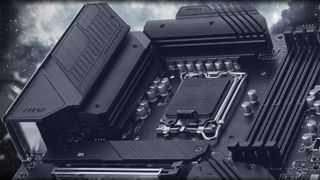First B760 Motherboard Images Leak, Minimal Upgrade Over B660
PCIe Lane bump and some aesthetic changes over last-gen.

Videocardz shared a post earlier this morning showing leaked images of MSI's upcoming B760 Tomahawk motherboard. This is the first motherboard we've seen to date packing Intel's yet-to-be-announced B760 chipset. The motherboard greatly resembles its B660 predecessor, featuring the same ATX form factor, and design language. The motherboard also appears to share the same amount of storage options and PCIe slots as its predecessor, confirming previous rumors that B760 won't be a massive upgrade over B660.
This MSI motherboard, along with other B760 models from other vendors, should be released sometime in early 2023, after Intel officially announces its B760 chipset, likely at CES 2023, which starts on January 5th.
Intel released the higher-end Z790 chipset alongside three fully unlocked processors when its 13th Generation Raptor Lake CPUs launched a few months ago. Intel decided to hold back the release of its non-overclockable 65W CPUs, and its lower-end 700 series chipsets until next year.
But during the launch Intel let slip SATA, USB and PCIe specifications for all 700 series chipsets, giving us a good idea of B760's capabilities. The chipset will not be a significant upgrade over B660 in any shape or form. The only noteworthy upgrade is a change of PCIe revisions from Gen 3 to Gen 4 on some of the chipset lanes. So you'll get some more bandwidth for add-in cards and fast storage compared to B660.
Videocardz' images demonstrate this fact quite clearly, with the B760 Tomahawk. The board has a near identical layout to its predecessor, with the same amount of SATA ports, PCIe slots and M.2 storage solutions. We expect some of these slots will be upgraded to Gen 4, but users will get the same amount of physical slots and connectors as the previous generation board.
Rear I/O shares the same story, with the B760 Tomahawk having the same amount of USB ports, audio ports, and internet connectivity options as the B660 version. But, four of the Type-A ports have been upgraded to 10Gbps, you get 20Gbps on the Type-C port and a WiFi upgrade from version 6 to 6E. So at least there is an upgrade here in some form. But if the price increases quite a bit from this gen to the last, and this board is an indication of what's to come for B670, lots of people building mainstream gaming and computing rigs are going to be better off opting for the B660 options as long as they're still available.
B760 Will Be More Expensive
These minor upgrades would be fine if platform prices remained the same, but sadly this will not be the case. We recently covered a report that expects B760 prices to jump by 10% over B660 upon release.
Stay on the Cutting Edge
Join the experts who read Tom's Hardware for the inside track on enthusiast PC tech news — and have for over 25 years. We'll send breaking news and in-depth reviews of CPUs, GPUs, AI, maker hardware and more straight to your inbox.
We expect this price hike to affect B760's sales in a noticeably way. Most mainstream consumers will rarely ever use the capabilities PCie Gen 4, and ultra fast USB connectivity can offer. Most of Intel's B series chipset motherboards are used in standard consumer applications that involve causal browsing, gaming, and video playback duties.
This is compounded by the fact Intel's B660 chipset is already a very capable platform for support of both 12th Gen Alder Lake and 13th Gen Raptor Lake parts - with the only requirement being a BIOS update to unlock 13th Gen compatibility.
This should incentives buyers to go back and buy Intel's older B660 platform which offer the same computing experience as its successor, save for the select few who will actually utilize B760's higher bandwidth ports. Hopefully Intel's partners can find ways to make B760 more competitive, but it seems like B660 will be the best budget option for both Alder Lake and Raptor Lake systems.

Aaron Klotz is a freelance writer for Tom’s Hardware US, covering news topics related to computer hardware such as CPUs, and graphics cards.
-
PlaneInTheSky Reply2.5Gbps ethernet
20Gbps Type-C port
USB-C on these mobo is 8 times faster than Ethernet.
This strategy of only offering 2.5G ethernet instead of 10G is really weird. -
lmcnabney ReplyPlaneInTheSky said:This strategy of only offering 2.5G ethernet instead of 10G is really weird.
A home switch that support 2.5gb to 5 devices is around $120 while the same for 10gb is around $250. Then recall that wifi 6e is pushing 5gb. The decision to move up from gigE is not so obvious. The incremental move to wired 2.5 and wireless 2.5-5 makes more sense. There just aren't that many people that need 10gb ethernet. Their needs can be met with a network card. Adding 10gb native connectivity is expensive and consumes a limited number of available channels. -
InvalidError Reply
Most people only use their LAN to connect to their router and share a sub-1Gbps internet connection, no point in wasting a ton of cash there upgrading to 10Gbps on a mid-range motherboard that may never even be used at anywhere near 2.5Gbps.PlaneInTheSky said:This strategy of only offering 2.5G ethernet instead of 10G is really weird.
USB3+ on the other hand is most frequently used to move files between internal and external storage, which can quite easily go beyond 10Gbps when both the source and destination are NVME SSDs.
Most Popular




